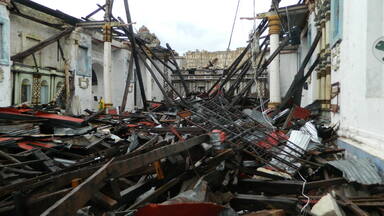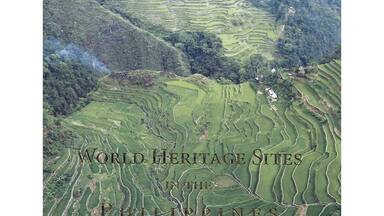Baroque Churches of the Philippines
Baroque Churches of the Philippines
These four churches, the first of which was built by the Spanish in the late 16th century, are located in Manila, Santa Maria, Paoay and Miag-ao. Their unique architectural style is a reinterpretation of European Baroque by Chinese and Philippine craftsmen.
Description is available under license CC-BY-SA IGO 3.0
Églises baroques des Philippines
Ces quatre églises, situées dans les villes de Manille, Santa Maria, Paoay et Miag, et dont la première fut construite dès la fin du XVIe siècle par les Espagnols, sont représentatives d'un style unique en son genre où le baroque européen a été réinterprété par les artisans philippins et chinois.
Description is available under license CC-BY-SA IGO 3.0
الكنائس الباروكيّة في الفليبين
تقع هذه الكنائس الاربع في كل من مدينة مانيلا وسانتا ماريا وباواي ومياغ. أقدمها بُنيت منذ أواخر القرن السادس عشر على يد الاسبان. وتمثّل هذه الكنائس أسلوبًا فريدًا من نوعه حيث غيّر الحرفيون الفليبيون والصينيون في النمط الباروكي الاوروبي على طريقتهم.
source: UNESCO/CPE
Description is available under license CC-BY-SA IGO 3.0
菲律宾的巴洛克教堂
这4座教堂分别坐落在马尼拉、圣玛丽亚、帕瓦伊和米亚高,其中第一座由西班牙于16世纪后期建造。它们那独特的欧洲巴洛克式的建筑风格在中国和菲律宾工匠的手中得以再现。
source: UNESCO/CPE
Description is available under license CC-BY-SA IGO 3.0
Церкви Филиппин в стиле барокко
Эти четыре церкви, первая из которых была построена испанцами в конце XVI в., расположены в Маниле и городках Санта-Мария, Паоай и Миагао. Их уникальный архитектурный стиль – результат интерпретации европейского барокко китайскими и филиппинскими мастерами.
source: UNESCO/CPE
Description is available under license CC-BY-SA IGO 3.0
Iglesias barrocas de Filipinas
El sitio consta de cuatro iglesias situadas en las ciudades de Manila, Santa María, Paoay y Miag. La primera de ellas fue construida a finales del siglo XVI por los españoles. Todos estos monumentos son representativos de un estilo arquitectónico excepcional, fruto de la reinterpretación del barroco europeo por parte de los artesanos filipinos y chinos que participaron en su construcción.
source: UNESCO/CPE
Description is available under license CC-BY-SA IGO 3.0
フィリピンのバロック様式教会群
source: NFUAJ
Barokkerken van de Filippijnen
Deze vier kerken, waarvan de eerste door de Spanjaarden gebouwd werd in de laat 16e eeuw, staan in Manilla, Santa Maria, Paoay en Miag-ao. Hun unieke architectonische stijl is een herinterpretatie van de Europese barok door Chinese en Filippijnse ambachtslieden. De bouwstijl en het ontwerp werden aangepast aan de fysieke omstandigheden in de Filippijnen. De kerk San Augustin in Paoay is duidelijk op aardbevingen berekend, de klokkentoren staat op veilige afstand van de kerk. De kerken zijn gebouwd met lokale materialen en versierd met decoratieve motieven. Ze hebben een belangrijke invloed gehad op de latere kerkarchitectuur in de regio.
Source: unesco.nl
Outstanding Universal Value
Brief synthesis
The Baroque Churches of the Philippines is a serial inscription consisting of four Roman Catholic churches constructed between the 16thand the18th centuries in the Spanish period of the Philippines. They are located in separate areas of the Philippine archipelago, two at the northern island of Luzon, one at the heart of Intramuros, Manila, and the other in the central Visayas island of Iloilo.
This group of churches established a style of building and design that was adapted to the physical conditions in the Philippines and had an important influence on later church architecture in the region. The four churches are outstanding examples of the Philippine interpretation of the Baroque style, and represent the fusion of European church design and construction with local materials and decorative motifs to form a new church-building tradition.
The common and specific attributes of the churches are their squat, monumental and massive appearance, which illustrates a fortress/protective-like character in response to pirates, marauders and to the geologic conditions of a country that is prone to seismic activities. The churches are made either of stone (tuff or coralline limestone), or brick, and consolidated with lime. They display specific features such as retablos (altars) of high Baroque style – (particularly seen in San Agustin Church, Intramuros), in the volutes of contrafuertes (buttresses) and in the pyramidal finials of wall facades – (particularly seen in Paoay Church), in wall buttresses separating criptocollateral chapels –(particularly seen in San Agustin Church, Intramuros) and in the iconography of the ornately decorated naïf/folk pediment expressing the local understanding of the life of Christ and demonstrated by the use of local elements (papaya, coconut and palm tree reliefs), and the depiction of Catholic Patron Saints (St. Christopher) dressed in local and traditional clothing (particularly seen in the Miagao Church). The fusion of styles is also seen in the construction of bell towers that are either attached to the main church structure (particularly seen in San Agustin, Intramuros and in Miagao churches) or detached from the main church (particularly seen in Paoay and Sta Maria churches) and lastly, in ceiling paintings in the tromp l’oeil style (particularly seen in San Agustin Church, Intramuros). The Baroque churches reflect excellent site planning principles following the Ley de las Indias (Laws of the Indies) enacted by Philip II in 1563 for all newly-discovered settlements within Spanish colonial territories.
Criterion (ii): The group of churches established a style of building and design that was adapted to the physical conditions in the Philippines which had an important influence on later church architecture in the region.
Criterion (iv): The Baroque Churches of the Philippines represent the fusion of European church design and construction using local materials and decorative motifs to form a new church-building tradition.
Integrity
The churches’ important attributes comprising its architectural ensemble and manifesting the uniqueness of their style, are all within the boundaries of the property. All elements of significance identified at the time of inscription are still very much present and none are eroded, with their dynamic functions associated with religious significance intact and well-maintained.
The churches’ fabric, to a considerable degree is well preserved, although some parts may have deteriorated due to environmental conditions and the passage of time.
Although areas covered by the churches and their surrounding complex have been recognized during inscription, buffer zones in some of them were undefined. The recent delineation of buffer areas provides an added layer of protection to the core initially identified.
Authenticity
The Baroque Churches of the Philippines of the ‘Peripheral Baroque Style’ have maintained its authentic features and admirable building technology that is reflective of church architecture of 16th-18th centuries Spanish colonial period Philippines A potential threat to the property is the possible reconstruction of portions of some of the churches’ original ensemble which were not present during inscription, in the effort to ensure that the churches continue to function to best serve their congregations.
The efforts by the government geared towards responsible restoration and conservation have resulted in the retention of the original materials and substantial features of the baroque churches.
The use of the Baroque churches as permanent sacred places devoted to acts of divine worship of the Catholic faith continues.
Protection and management requirements
Three churches and their land properties are legally owned, administered, and managed by their respective corporations sole while one church (San Agustin, Intramuros) is owned and managed by the Agustinian Order. The churches have been traditionally administered by church authorities and parishioners. Specific church Management Plans were not prepared at the time of inscription but the San Agustin Church in Intramuros is covered by the Management Plan of the Intramuros Administration. There is an overall management system where the National Commission for Culture and the Arts (NCCA) is the overall site manager. The NCCA works with its culturally affiliated agencies – the National Museum (NM) and the National Historical Commission of the Philippines (NHCP) who are the implementers of conservation and restoration projects. Altogether the three agencies collaborate closely with the church authorities-owner of the property and with the stakeholders as well who are made aware of projects on the churches. The day to day management of the church is undertaken by the church authorities. There is a tri-partite agreement for the conservation and management of the World Heritage property as well as other nationally designated heritage sites. The main actors of the tri-partite agreement are the NCCA, the NM, the NHCP and the church authorities.
At the time of inscription, the properties had already been strongly protected by national legislation declaring them as National Cultural Treasures and as National Historical Landmarks through Presidential Decrees 260 and 375. The National Commission of Culture and the Arts provides for resources (funds) for its conservation, protection and regular maintenance.
The churches are presently covered and protected through RA 10066 (National Heritage Law) and RA 10086 (National Historical Commission of the Philippines Law). These legislations ensure their proper safeguarding, protection, conservation, management and use as religious structures, as declared National Cultural Treasures, National Historical Landmarks, and as World Heritage properties. A strong administrative protection system is in place through a Tripartite Agreement between the different national cultural government agencies while agreements between Church authorities and the Government have been entered into, especially the Accordo between the Holy See and the Republic of the Philippines on the Cultural Heritage of the Catholic Church in the Philippines, which was ratified on 29 May 2008. The Implementing Rules and regulations (IRR) of the 2009 Cultural Heritage Act of the Philippines, which is still in the process of being approved, states that the highest standards of conservation shall be applied to World Heritage properties and that its authenticity, integrity and OUV shall not be allowed to be compromised.
Conservation and restoration are undertaken through offices under implementing national cultural agencies which ensure the regular monitoring of its state of conservation including its many concerns, threats and problems. The Canon Law on the pastoral care of the cultural heritage resources of the Church is likewise being applied by the Catholic authorities. The site manager of the Baroque Churches (NCCA) works with the NM and NHCP in ensuring that work is done according to World Heritage standards and in order to improve the conservation management processes so that the Outstanding Universal Value of the properties are maintained and properly managed. If in case repairs are done that involve the replacement of deteriorated parts, these are undertaken with care so that the replaced areas are differentiated from the original.
Both affiliated cultural agencies sit at the National Commission for Monuments and Sites (NCMS) as ex-officio members. A Technical Working Committee (TWC) has also been established within the NCCA composed of experts on conservation and its members ensure that the highest standards of conservation are afforded to World Heritage properties. Both the NM and the NHCP are the implementers of projects in the Baroque Churches and they too sit as members of the NCCA, NCMS and TWC.
Involvement of local communities is strongly encouraged and they are considered important stakeholders where their views are listened to in consultative processes. Church authorities’ involvement in all aspects is vital and they also form an essential part of agreements to ensure that conservation is undertaken at their level, being owners of the properties.

 View photos from OUR PLACE the World Heritage collection
View photos from OUR PLACE the World Heritage collection


